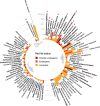Over 90 endangered fish and invertebrates are caught in industrial fisheries
- PMID: 32958769
- PMCID: PMC7506527
- DOI: 10.1038/s41467-020-18505-6
Over 90 endangered fish and invertebrates are caught in industrial fisheries
Abstract
Industrial-scale harvest of species at risk of extinction is controversial and usually highly regulated on land and for charismatic marine animals (e.g. whales). In contrast, threatened marine fish species can be legally caught in industrial fisheries. To determine the magnitude and extent of this problem, we analyze global fisheries catch and import data and find reported catch records of 91 globally threatened species. Thirteen of the species are traded internationally and predominantly consumed in European nations. Targeted industrial fishing for 73 of the threatened species accounts for nearly all (99%) of the threatened species catch volume and value. Our results are a conservative estimate of threatened species catch and trade because we only consider species-level data, excluding group records such as 'sharks and rays.' Given the development of new fisheries monitoring technologies and the current push for stronger international mechanisms for biodiversity management, industrial fishing of threatened fish and invertebrates should no longer be neglected in conservation and sustainability commitments.
Conflict of interest statement
The authors declare no competing interests.
Figures



References
-
- FAO. The State of World Fisheries and Aquaculture 2020: Sustainability in Action (FAO, 2020).
-
- Diaz, S. et al. Summary for Policymakers of the Global Assessment Report on Biodiversity and Ecosystem Services of the Intergovernmental Science-Policy Platform on Biodiversity and Ecosystem Services, IPBES (2019).
-
- FAO. The State of World Fisheries and Aquaculture 2018—Meeting the Sustainable Development Goals (FAO, 2018).
-
- IUCN. The IUCN Red List of Threatened Species. Version 2019-1 (IUCN, 2019). https://www.iucnredlist.org.
-
- McClenachan L, Cooper AB, Carpenter KE, Dulvy NK. Extinction risk and bottlenecks in the conservation of charismatic marine species. Conserv. Lett. 2012;5:73–80.
Publication types
MeSH terms
LinkOut - more resources
Full Text Sources
Other Literature Sources

